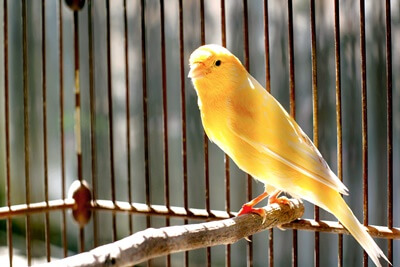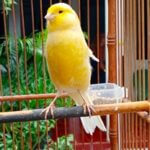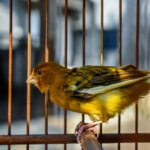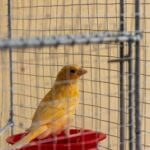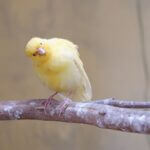When a female canary becomes gravid, she’ll develop eggs inside her body.
Once ready, she’ll release them from her cloaca over 1-2 days. If the egg-laying process takes longer, the chances are that the canary is egg-bound (known as dystocia).
When a canary is egg-bound, she’s unable to lay eggs because they’re too big (double-yolked), abnormally shaped, or the muscles might be incapable of pushing them out.
What Does An Egg-Bound Canary Look Like?
Canaries hide the symptoms of illness as a defense mechanism to prevent predatory animals from noticing they’re vulnerable. Unfortunately, it can make the signs of egg binding subtle.
A female canary may become egg-bound on the first egg, the last egg, or one in between. No matter the case, an inability to lay developed eggs can be fatal if left unresolved.
Each day, check for the main egg-binding symptoms, which include:

Straining
Straining is a reliable sign of egg binding. You’ll notice this as ruffled feathers, leaning back or forward, twitching her tail, and straining her muscles.
Upon close inspection, you may see the area around the female’s vent physically straining.
Swelling
When an egg is stuck, it can push against the internal organs, causing the area around it to swell.
Egg-bound birds will have a swollen abdomen, or the area around the vent will be stretched thin due to pressure from an egg.
Distended Belly
If you suspect your canary is egg-bound, gently feel along its belly. It may appear visually distended, or if the feathers hide it, you’ll feel a firm pressure under the skin in the shape of an egg.
Labored Breathing
Most egg-bound females have elevated or heavy breathing. It’ll appear as though they’ve just finished a strenuous exercise, even if they haven’t moved for some time.
Constipation
Birds expel their waste and lay their eggs through the same opening, called the vent. Eggs that are bound will block the vent, preventing waste from being expelled.
This will result in constipation or diarrhea, so be wary if your gravid canary produces abnormal droppings or stops pooping altogether. Canaries poop many times a day, so this should be readily apparent.
Lameness
Bound eggs can exert pressure on the nerves connected to the bird’s legs.
When this happens, the female can become lame or be unable to stand. Eggs can also force pressure on the spine, which makes the canary unable to move.
Sitting On The Bottom Of The Cage
Your canary may sit at the bottom of the cage out of stress, pain, or lameness..
If you notice that your canary can’t perch, is huddled on the floor of its cage, or appears to be lying on its side, it’s most likely egg-bound.
What Causes Egg Binding In Canaries?
Here are the causes of egg binding in canaries and what you can do about them:
All-Seed Diet
A diet lacking protein often causes egg binding. Canaries fed an all-seed diet often grow deficient in minerals, vitamins, and other vital nutrients.
That can leave the female’s eggs deformed or her muscles too weak to push normal eggs out.
So, switch to a formulated pellet diet. This should be supplemented with fruits, grains, veggies, and supplements for extra calcium, magnesium, and vitamin D.
Obesity
Obese canaries usually subsist on a diet high in fat and calories but low in nutrients, and this can result in weak eggs that break or get lodged inside the canary.
Furthermore, obese birds find it difficult to exercise and often live sedentary lives. This leaves their muscles weak and, thus, unable to properly lay the eggs they develop.
Lack of Exercise
If your canary lives in a small cage and can’t exercise, it’ll begin to lose muscle mass. Even with a well-optimized diet and correct weight, the canary may be unable to push out the eggs.
Calcium Deficiency
Birds that are deficient in calcium will form eggs that are thin or soft-shelled.
The canary’s internal muscles require a hard surface to push against, allowing them to smoothly guide the eggs through the cloaca. The eggs will bend due to muscle pressure if the shells are soft.
This can make them impossible to move, thus becoming stuck. Such eggs can also collapse within the canary, leaving the yolk to drain out of the cloaca while the remaining egg fragments stay inside.
Likewise, calcium is necessary for muscle contractions. Without sufficient calcium, a canary’s muscles may not be strong enough to push out an egg.
According to the Biological Journal of the Linnean Society, the availability of calcium dramatically increases the chances of successful breeding and uncomplicated egg-laying in the wild.
So, providing cuttlebones, calcium blocks, or liquid supplements is important.
Vitamin D Deficiency
Vitamin D is necessary for absorbing calcium. If your canary is deficient in vitamin D, it’ll consume plenty of calcium but won’t properly distribute or process it throughout its body.
This will leave the canary deficient, even if you provide calcium supplements. So, when it’s time to lay eggs, the bird may produce weak shells or struggle with weak muscles.
Be sure to offer vitamin D supplements leading up to the breeding season.
Excessive Egg-Laying
Chronic egg-laying birds are more likely to become egg-bound than others because developing eggs takes a lot of calcium, which can lead to deficiency.
Likewise, if her cloaca is strained from over-use, she may have damaged muscles or lack the energy to push out her eggs. That makes it wise to avoid over-breeding your canaries and always provide calcium supplements between clutches.
If your canary is laying unfertilized eggs without breeding, this can still affect her future egg-laying success. However, you can discourage the behavior by diminishing her exposure to sunlight and removing nest-building materials.
Abnormal Egg
Perhaps because of diet, genetics, or misfortune, a female may develop abnormal eggs. They may be too big, too small, positioned wrongly, or have incredibly soft shells.
These eggs will be harder to push out or may physically block the vent due to their size. A vet must remove such eggs to prevent impaction.
Injuries To Reproductive Organs
Egg binding may be caused by swelling of the reproductive organs due to physical trauma, infection, tumors, or inflammation. These must be addressed before the breeding season to avoid egg binding.
Illness
If your canary has recently been sick, it’s at higher risk of egg binding. Illnesses – whether viral, fungal, parasitic or bacteria – can affect the entire body and weaken the canary.
Your canary may lack the energy to push out its eggs, have weakened muscles, or suffer from a mineral deficiency that results from the sickness.
How Long Can An Egg-Bound Canary Live?
Most canaries that are egg-bound will die within 48 hours if left untreated. Smaller birds, like canaries, present symptoms sooner and die more quickly than larger bird species.
What Can You Do For An Egg-Bound Canary?
If you’re concerned that your canary is egg-bound, take it to a vet immediately. If it’s outside of office hours, look for an emergency vet that treats animals 24/7.
If you must wait for a vet, your best approach is to provide supportive care for your canary.
Calm Environment
Egg-bound canaries will feel ill and stressed, so place them in an area that’s calm, quiet, and dark. Remove other pets from the room, close windows to limit noise, and perhaps set a blanket over the cage.
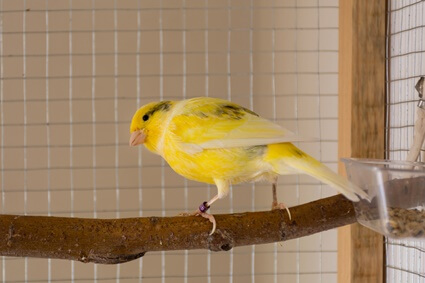
Handle Gently
Egg-bound canaries must be handled gently to avoid collapsing the egg. Avoid touching them, but if you need to, handle them with care. Avoid applying any pressure to the abdomen or vent.
Warm Area And Bath
Egg-bound canaries should be set in a warm room, ideally between 80-85 degrees Fahrenheit.
Place the canary in a warm bath, ensuring that the water covers her vent but doesn’t submerge her any further, or else it will pose a water inhalation risk.
The warm water will relax her muscles, help her pass the egg, and comfort the strained vent area.
Lubricate
Depending on where the egg is stuck, applying lubricant around the vent may help the egg to slide out. If it’s bound higher up in her reproductive tract, there’s little you can do without a vet.
Massage
If you need to help your canary without a vet, you can attempt to massage the area where the egg is stuck. You can discern the location by feeling the lower abdomen and down toward the vent.
If a particular area feels tight and strained, massage two fingers above this area, gently pushing the egg down toward the vent. This is risky and shouldn’t be attempted if you can see a vet soon. Vets understand the urgency of egg binding and are likely to respond quickly.
You may break the egg and further complicate the condition. However, with the help of the warm water bath, lubrication around the vent area, and this gentle massaging motion, you may coax the egg through the reproductive tract.

